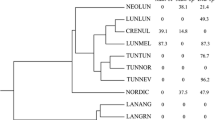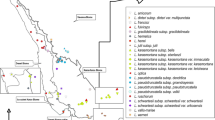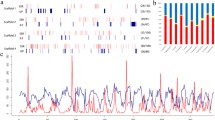Abstract
An electrophoretic comparison of variation at 16 presumptive isozyme gene loci was performed for 17 species from the tribeTriticeae. Included in the analysis were annuals and perennials, and self- and cross-pollinating species, representing the H, I, P, N, R, V, S, E, J, J1J2, A, B, and D genomes. Perennial species were found to contain a significantly (marginally, at the 5% level) higher proportion of polymorphic loci and level of heterozygosity, than annual species. There were no significant differences between self- and crosspollinating species. Across all species, mean heterozygosity levels ranged from 0–0.225 and the % polymorphic loci from 6.3–56.3%. Genetic distance estimates varied from 0.08–0.39 for congeneric species. Relationships were deduced between the 17 species using phenetic and cladistic analyses and compared with relationships inferred from other parameters such as morphology and nucleotide sequence data. In general, the trees derived from the various relationships were concordant; the evolutionary basis for minor discrepancies between trees is also discussed.
Similar content being viewed by others
References
Arnold, M. L., Baker, R. J., Honeycutt, R. L., 1983: Genic differentiation and phylogenetic relationships within two New World bat genera. — Biochem. Syst. Zool.11: 295–303.
Asins, M. J., Carbonell, E. A., 1986a: A comparative study on variability and phylogeny ofTriticum species. 1. Intraspecific variability. — Theor. Appl. Genet.72: 551–558.
—, —, 1986b: A comparative study on variability and phylogeny ofTriticum species. 2. Interspecific relationships. — Theor. Appl. Genet.72: 559–568.
Avise, J. C., Aquadro, C. F., 1982: A comparative summary of genetic distances in the vertebrates. — Evol. Biol.15: 151–185.
—,Patton, J. C., Aquadro, C. F., 1980a: Evolutionary genetics of birds. I. Relationships among North American thrushes and allies. — The Auk97: 135–147.
—, —, —, 1980b: Evolutionary genetics of birds. II. Conservative protein evolution in North American sparrows and relatives. — Syst. Zool.29: 323–334.
Ayala, F. J., 1975: Genetic differentiation during the speciation process. — Evol. Biol.8: 1–78.
—,Tracey, M. L., Barr, L. G., McDonald, J. F., Perez-Salas, S., 1974: Genetic variation in natural populations ofDrosophila species and the hypothesis of the selective neutrality of protein polymorphisms. — Genetics77: 343–384.
Baverstock, P. R., Archer, M., Adams, M., Richardson, B. K., 1982: Genetic relationships among 32 species of Australian dasyurid marsupials. — InArcher, M., (Ed.): Carnivorous marsupials, pp. 641–650. — Royal Society of N.S.W.
Benito, C., Figueiras, A. M., Gonzalez-Jaen, M. T., 1985a: Phosphogluco mutase—a biochemical marker for group 4 chromosomes in theTriticinae. — Theor. Appl. Genet.6 B: 555–557.
—, —, —, 1985b: Biochemical evidence of homoeology between wheat and barley chromosomes. — Z. Pflanzenzüchtung94: 307–320.
—, —, —, 1987: Location of genes coding isozyme markers onAegilops umbellulata chromosomes adds data on homoeology amongTriticeae chromosomes. — Theor. Appl. Genet.73: 581–588.
Bosch, A., Figueiras, A. M., Gonzalez-Jaen, M. T., Benito, C., 1986: Leaf peroxidases — a biochemical marker for the group 2 chromosomes in theTriticinae. — Genet. Res.47: 103–107.
Britten, R. J., 1986: Rates of DNA sequence evolution differ between taxonomic groups. — Science231: 1393–1398.
Brody, T., Mendlinger, S., 1980: Species relationships and genetic variation in the diploid wheats (Triticum, Aegilops) as revealed by starch gel electrophoresis. — Pl. Syst. Evol.136: 247–258.
Brown, A. H. D., Matheson, A. C., Eldridge, K. G., 1975: Estimation of the mating system ofEucalyptus obliqua L'Herit. by using allozyme polymorphisms. — Austral. J. Bot.23: 931–949.
—,Nevo, E., Zohary, D., Dagan, O., 1978a: Genetic variation in natural populations of wild barley (Hordeum spontaneum). — Genetica49: 97–108.
—,Zohary, D., Nevo, E., 1978b: Outcrossing rates and heterozygosity in natural populations ofHordeum spontaneum Koch. in Israel. — Evolution33: 815–833.
Bruce, E. J., Ayala, F. J., 1979: Phylogenetic relationships between man and the apes: electrophoretic evidence. — Evolution33: 1040–1056.
Coyne, J. A., 1982: Gel electrophoresis and cryptic protein variation. — InRatazzi, M. C., Scandalios, J. G., Whitt, G. S., (Eds.): Isozymes: Current topics in biological and medical research6, pp. 1–32. — New York: Liss Inc.
Dewey, D. R., 1984: The genomic system of classification as a guide to intergeneric hybridization with the perennialTriticeae. — Stadler Genetics Symposium16: 209–280.
Farris, J. S., 1972: Estimating phylogenetic trees from distance matrices. — Amer. Naturalist106: 645–668.
Feldman, M., 1966: Identification of unpaired chromosomes in F1 hybrids involvingTriticum aestivum andT. timopheevii. — Canad. J. Genet. Cytol.8: 144–151.
Gill, B. S., Appels, R., 1988: Relationships betweenNor-loci from differentTriticeae species. — Pl. Syst. Evol.160: 77–89.
Goodman, M., Weiss, M. L., Czelusniak, J., 1982: Molecular evolution above the species level: branching pattern, rates, and mechanisms. — Syst. Zool.31: 376–399.
Gottlieb, L. D., 1973: Enzyme differentiation and phylogeny inClarkia franciscana, L. rubicunda andC. amoena. — Evolution27: 205–214.
—, 1976: Electrophoretic evidence and plant systematics. — Ann. Missouri Bot. Gard.64: 161–180.
Harris, H., Hopkinson, D. A., 1976: Handbook of electrophoresis in human genetics. — Amsterdam: North-Holland.
Hart, G. E., 1983: Hexaploid wheat (Triticum aestivum L. em.Thell). — InTanksley, S. D., Orton, T. J., (Eds.): Isozymes in plant genetics and breeding, Part B, pp. 35–56. — Amsterdam: Elsevier Science Publishers.
—,Islam, A. K. M. R., Shepherd, K. W., 1980: Use of isozymes as chromosome markers in the isolation of wheat-barley chromosome addition lines. — Genet. Res.35: 311–325
Hennig, W., 1966: Phylogenetic systematics. — Urbana: Univ. Illinois Press.
Jaaska, V., 1976: Aspartate aminotransferase isoenzymes in the polyploid wheats and their diploid relatives on the origin of tetraploid wheat. — Biochem. Physiol. Pfl.170: 159–171.
—, 1978: NADP-dependent aromatic alcohol dehydrogenases in polyploid wheat and their diploid relatives. On the origin and phylogeny of polyploid wheat. — Theor. Appl. Genet.53: 209–217.
—, 1980: Electrophoretic survey of seedling esterases in wheats in relation to their phylogeny. — Theor. Appl. Genet.56: 273–284.
—, 1981: Aspartate aminotransferase and alcohol dehydrogenase isoenzymes: intraspecific differentiation inAegilops tauschii and the origin of the D genome polyploids in the wheat group. — Pl. Syst. Evol.137: 259–273.
Johnson, B. L., 1972: Seed protein profiles and the origin of the hexaploid wheat. — Proc. Natl. Acad. Sci. U.S.A.69: 1398–1402.
—,Dhaliwal, H. S., 1976: Reproductive isolation ofT. boeticum andT. urartu and the origin of the tetraploid wheat. — Amer. J. Bot.63: 1088–1094.
Kahler, A. L., Allard, R. W., Kratzakowa, C. F., Wehrhahn, C. F., Nevo, E., 1980: Association between isozyme phenotypes and environment in the slender wild oat (Avena barbata) in Israel. — Theor. Appl. Genet.56: 37–47.
Koebner, R. M. D., Shepherd, K. W., 1982: Shikimate dehydrogenase—a biochemical marker for group 5 chromosomes in theTriticinae. — Genet. Res.41: 209–213.
Kreitman, M., 1983: Nucleotide polymorphism at the alcohol dehydrogenase locus ofDrosophila melanogaster. — Nature304: 412–417.
Lanyon, S. M., 1985: Molecular perspective on higher-level relationships in theTyrannoidae (Aves). — Syst. Zool.34: 404–418.
Lawrence, G. J., Appels, R., 1986: Mapping the nucleolus organiser region, seed protein loci and isozyme loci on chromosome 1 R in rye. — Theor. Appl. Genet.71: 742–749.
Levy, M., Levin, D. A., 1975: Genic heterozygosity and variation in permanent translocation heterozygotes of theOenothera biennis complex. — Genetics79: 493–512.
Lewontin, R. C., 1985: Population genetics. — Ann. Rev. Genet.19: 81–102.
Löve, A., 1984: Conspectus of theTriticeae. — Feddes Repert.95: 425–521.
Loveless, M. D., Hamrick, J. L., 1984: Ecological determinants of genetic structure in plant populations. — Ann. Rev. Ecol. Syst.15: 65–95.
McIntyre, C. L., Clarke, B. C., Appels, R., 1988a: Amplification and dispersion of repeated DNA sequences in theTriticeae. — Pl. Syst. Evol.160: 39–59.
—, —, —, 1988b: DNA sequence analyses of the ribosomal spacer regions in theTriticeae. — Pl. Syst. Evol.160: 91–104.
Melderis, A., Humphries, C. J., Tutin, T. G., Heathcote, S. A., 1980: TribeTriticeae Dumort. — InTutin, T. G., & al. (Eds.): Flora Europaea5, pp. 190–206. — Cambridge: University Press.
Nei, M., 1978: Estimation of average heterozygosity and genetic distance from a small number of individuals. — Genetics89: 583–590.
Nevo, E., Zohary, D., Brown, A. H. D., Haber, M., 1979: Genetic diversity and environmental associations of wild barley,Hordeum spontaneum, in Israel. — Evolution33: 815–833.
—,Golenberg, E., Beiles, A., Brown, A. H. D., 1982: Genetic diversity and environmental association of wild wheat,Triticum dicoccoides, in Israel. — Theor. Appl. Genet.62: 241–254.
Patton, C., Baker, R. J., Avise, J. C., 1981: Phenetic and cladistic analyses of biochemical evolution in peromyscine rodents. — InSmith, M. H., Joule, J., (Eds.): Mammalian population genetics, pp. 288–308. — Athens: University of Georgia Press.
Powling, A., Islam, A. K. M. R., Shepherd, K. W., 1981: Isozymes in wheat-barley hybrid derivative lines. — Biochem. Genet.19: 237–253.
Prager, E. M., Wilson, A. C., 1976: Congruency of phylogenies derived from different proteins. A molecular analysis of the phylogenetic position of Cracid birds. — J. Mol. Evol.9: 45–57.
—, —, 1978: Construction of phylogenetic trees for proteins and nucleic acids: empirical evaluation of alternative matrix methods. — J. Mol. Evol.11: 129–142.
Rogers, J. S., 1972: Measures of genetic similarity and distance. Studies in Genetics VII. — University of Texas Publication7203: 145–153.
Roose, M. L., Gottlieb, L. D., 1976: Genetic and biochemical consequences of polyploidy inTragopogon. — Evolution30: 818–830.
Salinas, J., Figueiras, A. M., Gonzalez-Jaen, M. T., Benito, C., 1985: Chromosomal location of isozyme markers in wheat-barley addition lines. — Theor. Appl. Genet.70: 192–198.
Scoles, G. J., Gill, B. S., Xin, Z.-Y., Clarke, B. C., McIntyre, C. L., Chapman, C., Appels, R., 1987: Frequent duplication and deletion events in the 5 S RNA genes and the associated spacer regions of theTriticeae. — Pl. Syst. Evol.160: 105–122.
Shaw, C. R., Prasad, R., 1970: Starch gel electrophoresis of enzymes—a compilation of recipes. — Biochem. Genet.4: 297–320.
Sibley, C. G., Ahlquist, J. E., 1984: The phylogeny of the hominoid primates, as indicated by DNA-DNA hybridisation. — J. Mol. Evol.20: 2–15.
Sites, J. W., Bickham, J. W., Pytel, B. A., Greenbaum, I. F., Bates, B. A., 1984: Biochemical characters and the reconstruction of turtle phylogenies: relationships among batagurine genera. — Syst. Zool.33: 137–158.
Sneath, P. H. A., Sokal, R. R., 1973: Numerical taxonomy. — San Francisco: W. H. Freeman.
Swofford, D. L., 1984: Phylogenetic analysis using parsimony. Version 2.3. — Illinois Natural History Survey, Publication.
—,Selander, R. K., 1981: A computer program for the analysis of allelic variation in genetics. — J. Heredity72: 281–283.
Sytsma, K. J., Gottlieb, L. D., 1986: Chloroplast DNA evolution and phylogenetic relationships inClarkia sect.Peripetasma (Onagraceae). — Evolution40: 1248–1261.
—,Schaal, B. A., 1985a: Genetic variation, differentiation and evolution in a species complex of tropical shrubs based on isozyme data. — Evolution39: 582–592.
—, —, 1985b: Phylogenetics of theLisianthus skinneri (Gentianaceae) species complex in Panama utilising DNA restriction fragment analysis. — Evolution39: 594–609.
Tang, K. S., Hart, G. E., 1975: Use of isozymes as chromosome markers in wheat-rye addition lines and in triticale. — Genet. Res.26: 187–201.
Tice, R. R., Setlow, R. B., 1985: InSchneider, E. L., (Ed.): Handbook of the biology of aging, pp. 1–202. — New York: Van Nostrand Reinhold.
Tsvelev, N. N., 1904: Tribe 3.Triticeae Dum. — InPoaceae U.R.S.S., pp. 105–206. — Leningrad: Nauka.
Wang, R. R.-C., 1985: Genome analysis ofThinopyrum bessarabicum andT. elongatum. — Canad. J. Genet. Cytol.27: 722–728.
—, 1986a: Diploid perennial intergeneric hybrids in the tribeTriticeae. I.Agropyron cristatum ×Pseudoroegneria libanotica andCritesion violaceum ×Psathyrostachys juncea. — Crop Sci.26: 75–78.
—, 1986b: Diploid perennial intergeneric hybrids in the tribeTriticeae. II. Hybrids ofThinopyrum elongatum andPseudoroegneria spicata andCritesion violaceum. — Biol. Zentralbl.105: 361–368.
—, 1987: Diploid perennial intergeneric hybrids in the tribeTriticeae. III. Hybrids amongSecale montanum, Pseudoroegneria spicata andAgropyron mongolicum. — Genome29: 80–84.
Xin, Z.-Y., Appels, R., 1988: Occurrence of rye (Secale cereale) 350-family DNA sequences inAgropyron and otherTriticeae. — Pl. Syst. Evol.160: 65–76.
Zohary, D., 1966: The evolution of genomes inAegilops andTriticum. — InMackey, J., (Ed.): Proc. 2nd. Int. Wheat Genet. Symp. — Hereditas, Suppl.2: 207–217.
Author information
Authors and Affiliations
Rights and permissions
About this article
Cite this article
McIntyre, C.L. Variation at isozyme loci inTriticeae . Pl Syst Evol 160, 123–142 (1988). https://doi.org/10.1007/BF00936714
Received:
Issue Date:
DOI: https://doi.org/10.1007/BF00936714




